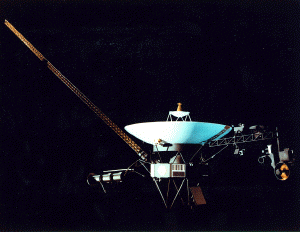The gas of electrically charged particles given off by the sun and expanding to fill the space between the planets is called the solar wind. We call such a gas a "plasma". As the solar wind expands at a very high speed (about 450 km/s on average at the Earth's orbit) the planets become supersonic projectiles moving through the gas and a shock is formed around the planet. We call this shock the "bow shock". Inside the region formed by the shock there is the region of space directly dominated by the planet's magnetic field and we call this the magnetosphere. Earth, Jupiter, Saturn, Uranus and Neptune all have magnetospheres. The interaction of Mercury, Venus and Mars with the solar wind is somewhat different as the magnetic fields of these planets is too weak to hold back the flow of the solar wind.
 The Voyager spacecraft, built by the Jet Propulsion Laboratory and a
team of scientists and engineers from around the country, were sent to
Jupiter and Saturn to provide measurements of the local environments of
these planets, their magnetospheres, and to take photographs of the
planets. These spacecraft flew through the bow shocks of the planets on
several occasions, providing direct measurements of this interaction of
the planet's environment with the solar wind. Voyager 2 has since gone on
to encounter the planets Uranus and Neptune while Voyager 1 was directed
up to high heliographic latitudes.
The Voyager spacecraft, built by the Jet Propulsion Laboratory and a
team of scientists and engineers from around the country, were sent to
Jupiter and Saturn to provide measurements of the local environments of
these planets, their magnetospheres, and to take photographs of the
planets. These spacecraft flew through the bow shocks of the planets on
several occasions, providing direct measurements of this interaction of
the planet's environment with the solar wind. Voyager 2 has since gone on
to encounter the planets Uranus and Neptune while Voyager 1 was directed
up to high heliographic latitudes.
The solar wind is a highly variable flow in the plane of the planets with the flow speed, density and temperature all varying by factors of 4 to 10. How the bow shock moves and responds to these changing conditions is not fully understood. By studying the bow shock at Saturn we hope to gain an opportunity to test the existing theories and perhaps gain insight into how those theories can be improved.
As an example of how the shock moves in response to changing solar wind conditions, we suggest you look at this fine simulation: http://pixie.spasci.com/DynMod/ and use your "Back" button to return to this page.